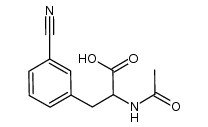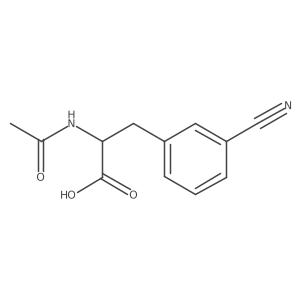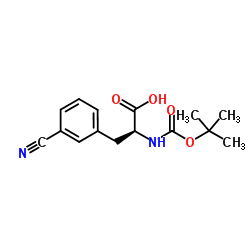57213-48-6
| 中文名 | L-3-氰基苯丙氨酸 |
|---|---|
| 英文名 | (S)-2-Amino-3-(3-cyanophenyl)propanoic acid |
| 中文别名 | 3-氰-L-苯基丙氨酸 |
| 英文别名 |
(S)-2-Amino-3-(3-cyanophenyl)propionic acid
3-Cyanophenylalanine L-phenylalanine, 3-cyano- L-3-Cyanophenylalanine (2S)-2-Amino-3-(3-cyanophenyl)propionic acid H-Phe(3-CN)-OH Phenylalanine, 3-cyano- (2S)-2-amino-3-(3-cyanophenyl)propanoic acid 3-Cyano-D-phenylalanine MFCD01860885 QVYZ1R CCN &&L or S Form H-D-Leu-Phe-OH |
| 描述 | H-Phe(3-CN)-OH是苯丙氨酸衍生物[1]。 |
|---|---|
| 相关类别 | |
| 体外研究 | 氨基酸和氨基酸衍生物已被商业化用作能量补充剂。它们影响合成代谢激素的分泌、运动期间的燃料供应、压力相关任务期间的精神表现,并防止运动引起的肌肉损伤。它们被认为是有益的能生膳食物质[1]。 |
| 参考文献 |
| 密度 | 1.3±0.1 g/cm3 |
|---|---|
| 沸点 | 382.5±32.0 °C at 760 mmHg |
| 分子式 | C10H10N2O2 |
| 分子量 | 190.199 |
| 闪点 | 185.1±25.1 °C |
| 精确质量 | 190.074234 |
| PSA | 87.11000 |
| LogP | 0.55 |
| 外观性状 | 白色至略黄色粉末 |
| 蒸汽压 | 0.0±0.9 mmHg at 25°C |
| 折射率 | 1.596 |
| 储存条件 | 密闭于0-6 ºC阴凉干燥环境中 |
| 稳定性 | 遵照规定使用和储存则不会分解。 |
| 分子结构 | 1、 摩尔折射率:50.45 2、 摩尔体积(m3/mol):148.3 3、 等张比容(90.2K):421.3 4、 表面张力(dyne/cm):65.1 5、 极化率(10-24cm3):20.00 |
| 计算化学 | 1.疏水参数计算参考值(XlogP):无 2.氢键供体数量:2 3.氢键受体数量:4 4.可旋转化学键数量:3 5.互变异构体数量:无 6.拓扑分子极性表面积87.1 7.重原子数量:14 8.表面电荷:0 9.复杂度:256 10.同位素原子数量:0 11.确定原子立构中心数量:1 12.不确定原子立构中心数量:0 13.确定化学键立构中心数量:0 14.不确定化学键立构中心数量:0 15.共价键单元数量:1 |
| 更多 | 1. 性状:无可用 2. 密度(g/mL,25/4℃):无可用 3. 相对蒸汽密度(g/mL,空气=1):无可用 4. 熔点(ºC):235 5. 沸点(ºC,常压):无可用 6. 沸点(ºC,5.2kPa):无可用 7. 折射率:无可用 8. 闪点(ºC):无可用 9. 比旋光度(º):-11(C=1, 水) 10. 自燃点或引燃温度(ºC):无可用 11. 蒸气压(kPa,25ºC):无可用 12. 饱和蒸气压(kPa,60ºC):无可用 13. 燃烧热(KJ/mol):无可用 14. 临界温度(ºC):无可用 15. 临界压力(KPa):无可用 16. 油水(辛醇/水)分配系数的对数值:无可用 17. 爆炸上限(%,V/V):无可用 18. 爆炸下限(%,V/V):无可用 19. 溶解性:无可用 |
Synonym: None Known. SECTION 2 - COMPOSITION, INFORMATION ON INGREDIENTS
Risk Phrases: 20/21/22 SECTION 3 - HAZARDS IDENTIFICATION EMERGENCY OVERVIEW Harmful by inhalation, in contact with skin and if swallowed.The toxicological properties of this material have not been fully investigated. Potential Health Effects Eye: May cause eye irritation. Skin: May cause skin irritation. Harmful if absorbed through the skin. Absorption into the body may cause cyanosis (bluish discoloration of skin due to deficient oxygenation of the blood).
Ingestion: Harmful if swallowed. May cause irritation of the digestive tract. The toxicological properties of this substance have not been fully investigated. Metabolism may release cyanide, which may result in headache, dizziness, weakness, collapse, unconsciousness and possible death. Inhalation: Harmful if inhaled. May cause respiratory tract irritation. The toxicological properties of this substance have not been fully investigated. May be metabolized to cyanide which in turns act by inhibiting cytochrome oxidase impairing cellular respiration. Chronic: Chronic exposure to cyanide solutions may lead to the development of a "cyanide" rash, characterized by itching, and by macular, papular, and vesicular eruptions, and may be accompanied by secondary infections. Exposure to small amounts of cyanide compounds over long periods of time is reported to cause loss of appetite, headache, weakness, nausea, dizziness, and symptoms of irritation of the upper respiratory tract and eyes. SECTION 4 - FIRST AID MEASURES Eyes: Flush eyes with plenty of water for at least 15 minutes, occasionally lifting the upper and lower eyelids. Get medical aid. Skin: Get medical aid. Flush skin with plenty of water for at least 15 minutes while removing contaminated clothing and shoes. Wash clothing before reuse. Ingestion: Never give anything by mouth to an unconscious person. Get medical aid. Do NOT induce vomiting. If conscious and alert, rinse mouth and drink 2-4 cupfuls of milk or water. Wash mouth out with water. Inhalation: Remove from exposure and move to fresh air immediately. If breathing is difficult, give oxygen. Get medical aid. Do NOT use mouth-to-mouth resuscitation. If breathing has ceased apply artificial respiration using oxygen and a suitable mechanical device such as a bag and a mask. Notes to Physician: SECTION 5 - FIRE FIGHTING MEASURES General Information: As in any fire, wear a self-contained breathing apparatus in pressure-demand, MSHA/NIOSH (approved or equivalent), and full protective gear. During a fire, irritating and highly toxic gases may be generated by thermal decomposition or combustion. Extinguishing Media: Use water spray, dry chemical, carbon dioxide, or chemical foam. SECTION 6 - ACCIDENTAL RELEASE MEASURES General Information: Use proper personal protective equipment as indicated in Section 8. Spills/Leaks: Vacuum or sweep up material and place into a suitable disposal container. Clean up spills immediately, observing precautions in the Protective Equipment section. Avoid generating dusty conditions. Provide ventilation. SECTION 7 - HANDLING and STORAGE Handling: Wash thoroughly after handling. Use with adequate ventilation. Minimize dust generation and accumulation. Avoid breathing dust, vapor, mist, or gas. Avoid contact with eyes, skin, and clothing. Keep container tightly closed. Avoid ingestion and inhalation. Storage: Store in a cool, dry place. Store in a tightly closed container. SECTION 8 - EXPOSURE CONTROLS, PERSONAL PROTECTION Engineering Controls: Facilities storing or utilizing this material should be equipped with an eyewash facility and a safety shower. Use adequate ventilation to keep airborne concentrations low. Exposure Limits CAS# 57213-48-6: Personal Protective Equipment Eyes: Wear appropriate protective eyeglasses or chemical safety goggles as described by OSHA's eye and face protection regulations in 29 CFR 1910.133 or European Standard EN166. Skin: Wear appropriate protective gloves to prevent skin exposure. Clothing: Wear appropriate protective clothing to prevent skin exposure. Respirators: Follow the OSHA respirator regulations found in 29 CFR 1910.134 or European Standard EN 149. Use a NIOSH/MSHA or European Standard EN 149 approved respirator if exposure limits are exceeded or if irritation or other symptoms are experienced. SECTION 9 - PHYSICAL AND CHEMICAL PROPERTIES Physical State: Powder Color: white to light yellow Odor: Not available. pH: Not available. Vapor Pressure: Not available. Viscosity: Not available. Boiling Point: Not available. Freezing/Melting Point: Not available. Autoignition Temperature: Not available. Flash Point: Not available. Explosion Limits, lower: Not available. Explosion Limits, upper: Not available. Decomposition Temperature: Solubility in water: Specific Gravity/Density: Molecular Formula: C10H10N2O2 Molecular Weight: 190.2 SECTION 10 - STABILITY AND REACTIVITY Chemical Stability: Not currently available. Conditions to Avoid: Dust generation. Incompatibilities with Other Materials: Oxidizing agents. Hazardous Decomposition Products: Nitrogen oxides, carbon monoxide, carbon dioxide. Hazardous Polymerization: Has not been reported SECTION 11 - TOXICOLOGICAL INFORMATION RTECS#: CAS# 57213-48-6 unlisted. LD50/LC50: Not available. Carcinogenicity: (S)-N-3-Cyanophenylalanine - Not listed by ACGIH, IARC, or NTP. SECTION 12 - ECOLOGICAL INFORMATION SECTION 13 - DISPOSAL CONSIDERATIONS Dispose of in a manner consistent with federal, state, and local regulations. SECTION 14 - TRANSPORT INFORMATION IATA Not regulated as a hazardous material. IMO Not regulated as a hazardous material. RID/ADR Not regulated as a hazardous material. SECTION 15 - REGULATORY INFORMATION European/International Regulations European Labeling in Accordance with EC Directives Hazard Symbols: XN Risk Phrases: R 20/21/22 Harmful by inhalation, in contact with skin and if swallowed. Safety Phrases: S 36/37 Wear suitable protective clothing and gloves. WGK (Water Danger/Protection) CAS# 57213-48-6: No information available. Canada None of the chemicals in this product are listed on the DSL/NDSL list. CAS# 57213-48-6 is not listed on Canada's Ingredient Disclosure List. US FEDERAL TSCA CAS# 57213-48-6 is not listed on the TSCA inventory. It is for research and development use only. SECTION 16 - ADDITIONAL INFORMATION MSDS Creation Date: 1/16/2002 Revision #1 Date: 9/05/2002 The information above is believed to be accurate and represents the best information currently available to us. However, we make no warranty of merchantability or any other warranty, express or implied, with respect to such information, and we assume no liability resulting from its use. Users should make their own investigations to determine the suitability of the information for their particular purposes. In no way shall the company be liable for any claims, losses, or damages of any third party or for lost profits or any special, indirect, incidental, consequential or exemplary damages, howsoever arising, even if the company has been advised of the possibility of such damages. SECTION 16 - ADDITIONAL INFORMATION N/A |
|
生态学数据: 该物质对环境可能有危害,对水体应给予特别注意。
|
| 危害码 (欧洲) | Xn:Harmful; |
|---|---|
| 风险声明 (欧洲) | R20/21/22 |
| 安全声明 (欧洲) | S26-S37/39 |
| 危险品运输编码 | UN3439 |
| 包装等级 | III |
| 危险类别 | 6.1 |
| 海关编码 | 2926909090 |
|
~33% 
57213-48-6 |
| 文献:WILEX AG Patent: WO2004/103984 A1, 2004 ; Location in patent: Page/Page column 12 ; WO 2004/103984 A1 |
|
~% 
57213-48-6 |
| 文献:WO2006/42678 A1, ; Page/Page column 11-12 ; |
| 上游产品 1 | |
|---|---|
| 下游产品 1 | |
| 海关编码 | 2926909090 |
|---|---|
| 中文概述 | 2926909090 其他腈基化合物. 增值税率:17.0% 退税率:9.0% 监管条件:无 最惠国关税:6.5% 普通关税:30.0% |
| 申报要素 | 品名, 成分含量, 用途 |
| Summary | HS:2926909090 other nitrile-function compounds VAT:17.0% Tax rebate rate:9.0% Supervision conditions:none MFN tariff:6.5% General tariff:30.0% |




